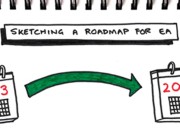Opinions vary regarding the value an architect adds in the world of project delivery. Some architects define their roadmaps and think their job is done and do not concern themselves with delivery of their architecture. However, delivery teams are frequently left wondering; what can we deliver within our budget, how do we deliver the roadmap and who can we partner with to deliver it.
I would argue that the real value of an architecture roadmap is only realised through its delivery into an organisation, little value is gained from a binder gathering dust on the bookshelf in the Chief Architect’s office. An architect must engage with project delivery and seek opportunities to add value by influencing scope, highlighting dependencies and assisting with vendor selection.
1) Influence Scope
The architect can play an important role in shaping what is delivered by influencing program managers and portfolio planners. The architect can play a vital role in influencing project scope by evangelising the architecture roadmap and the business benefit it delivers. I find that project delivery teams benefit from understanding the rationale behind the roadmap by participating in forums/brown bags organised by the architect. An architect who builds trust with delivery teams will more readily be able to influence the future delivery of the roadmap as the inevitable changes in scope occur during implementation.
2) Dependency Management
Architects can add value by working with the delivery teams to produce an implementation view of the roadmap. For example, a matrix that communicates to the project managers which capabilities are delivered by each project within the organisation and the dependencies between the capabilities. This can lead to models that highlight the time based dependencies between projects, for example the Call Centre project is introducing a new thin client CRM application which is dependent on tablets being delivered by an infrastructure project in Q3 2013.
3) Vendor Selection
A possible conflict between architecture and project delivery is the lack of engagement with incumbent delivery partners and internal vendor management. The architect has an opportunity to add value by engaging with vendor management early in the architecture life cycle to understand any impacts from a vendor perspective. An architect can assist vendor management by producing selection criteria during the RFP process to ensure the most appropriate vendor is considered. It is imperative architects are proactive and work with vendor management to ensure projects are not delayed due to poor vendor planning.
4) Be Valued!
Architects will be valued when they take an active role in the delivery of their architecture rather than a passive role ensconced in their ivory tower.



































Absolutely agree!!!! Finally, someone who has a similar viewpoint!
I’ve always believed, since my days at IBM, that the enterprise architects role is also to stay engaged and direct the deployment from a very high level.
We don’t need to be micro-managing the project to add value, but it’s surprising how many times I’ve seen scenarios where
1. Other ‘ experts’ at a customer know better and redesign your architecture after you’ve moved on.
2. IT decides that’s going to be too difficult to deploy and sidetrack or delay the project to death.
3. Another employee decides he’d like to take credit and alters your design in subtle ways that destroy scalability, DR/HA features, reliability in the cause of saving money.
4. Analysis paralysis sets in after you leave because of other hidden agendas, vested interests or vendor FUD.
5. If you’re not there, you can’t defend the logic behind your decision process, and guess what, it WILL be questioned as above.
All of this can be offset by the architect remaining engaged and supervising the deployment process, it’s his vision and he’s the one who knows how to get it done!
And free advice to the customer or client…
You paid me an awful lot of money to bring my expertise to your table. I guarantee you will fail if you then decide to listen to someone who is cheaper!
Sunil, I have experienced that too. However, I believe that issue you have described is more of a relationship management problem. Often people don’t understand what the artIctect’s intentions are and as a result people in projects don’t utilise them properly. Therefore, the EA needs to continue to push the right technical messages to the project team and (to the extend that) when longer terms implementation is compromised as a result, the EA then needs to start designing a a future state based on the new environment!
While i agree with the article from a broader perspective the article really dont address the key contentious issue of project management and their budgetry constraints with architects roadmap and its strategic value and hence in some cases architects are avoided or kept away by delivery even if the architect wish to participate and add value